Appendicitis Case Study: Nurse's Role, Child Development & Care
VerifiedAdded on 2023/06/05
|8
|2181
|81
Case Study
AI Summary
This case study examines the pathophysiology and nursing care involved in treating a 10-year-old girl, Anne, hospitalized with appendicitis. It discusses the importance of understanding the disease's progression, symptoms, and treatment, emphasizing the nurse's role in providing age-appropriate care based on Erikson's psychosocial theory. The study highlights the significance of family-centered care, outlining the nurse's responsibilities in communicating with and involving Anne's family in her treatment plan. Furthermore, it addresses the potential trauma and stress associated with hospitalization in children and stresses the need for empathetic interactions and family involvement to promote recovery and well-being. Desklib provides similar solved assignments for students.
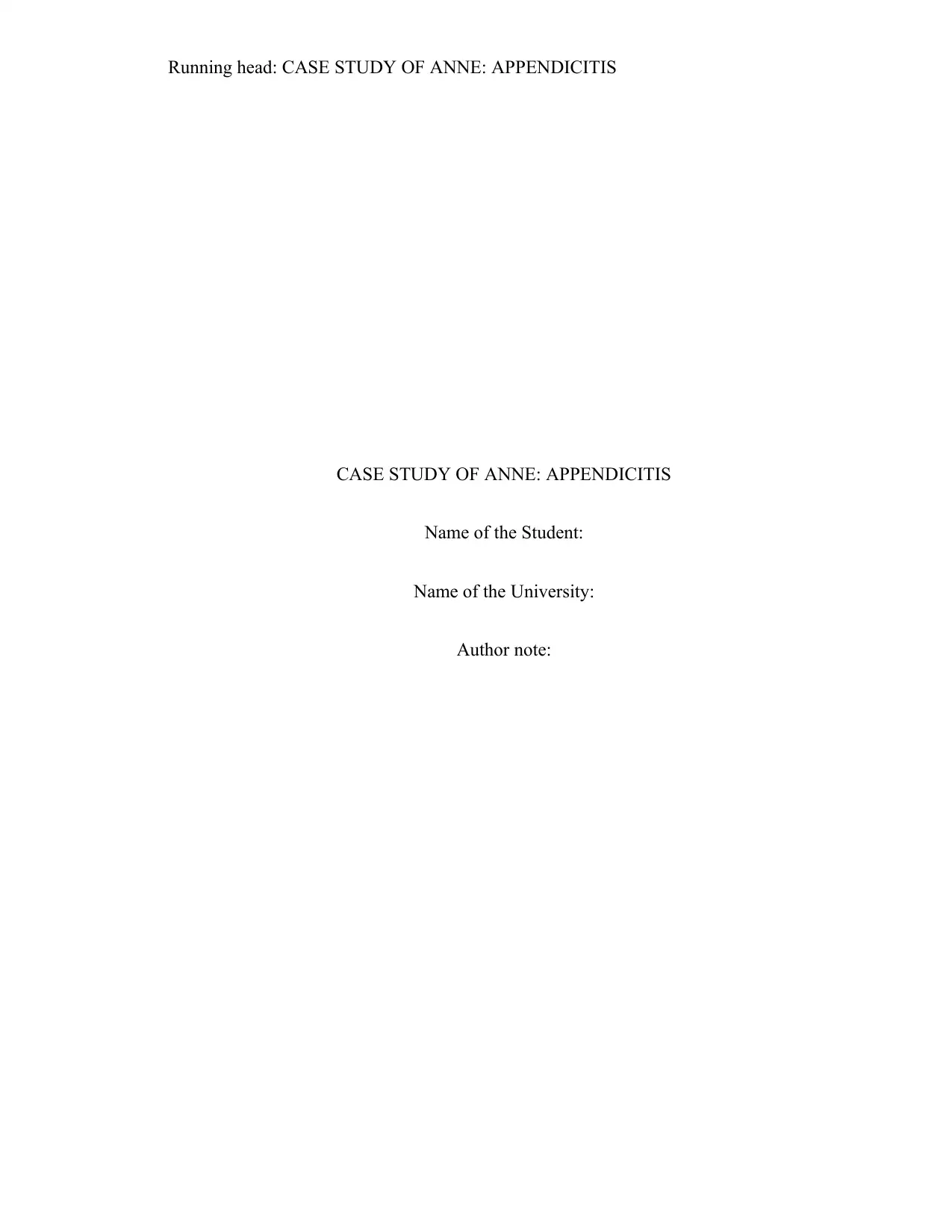
Running head: CASE STUDY OF ANNE: APPENDICITIS
CASE STUDY OF ANNE: APPENDICITIS
Name of the Student:
Name of the University:
Author note:
CASE STUDY OF ANNE: APPENDICITIS
Name of the Student:
Name of the University:
Author note:
Paraphrase This Document
Need a fresh take? Get an instant paraphrase of this document with our AI Paraphraser

1CASE STUDY OF ANNE: APPENDICITIS
The appendix of the human body, is a longitudinal mass of tissue with a blind end,
extending from the cecum, which is of a length of three and a half inches. A situation of
‘Appendicitis’ is considered a case of emergency which calls for an immediate medical and
surgical situation (Bhangu et al., 2015). The following essay outlines an extensive discussion of
the pathophysiology related to appendicitis, citing the example of Anne, a 10 year old girl who
received hospitalization upon severe abdominal pain. The latter sections of the essay sheds light
on the role of the nurse concerned with the delivery of care to the patient as well the concerned
family, the required knowledge of growth and developmental theories, as well an adequate
awareness regarding the implications of hospitalization on the patient.
In the human body, the appendix is situated in the abdomen, near the lower right section.
It emerges from the colon or cecum, and is comprised of tissues of lymphatic origin, which
further aids in enhancement in the body’s immunity. The appendix is scientifically referred to as
‘veriform’, due to its physical appearance resembling that of a worm. Appendicitis is the acute
inflammation, also known as peritonitis, of the inner tissues of the appendix, which commonly
escalates into a situation of emergency, resolved via surgery (Alavarado, 2018). The
pathophysiology of any disease, outlines its treatment. The pathophysiology of appendicitis
involves an interplay of factors leading to its inflammation. Accumulation of mucosal, bacterial,
as well as solid waste, such as stools, in the appendix, causing its blockage of the opening
towards the colon, is the key factor resulting in infection and inflammation of the same. Often
the extensive severity of the accumulation is followed by a rupturing or perforation of the
appendix tissues, as evident in the case study of Anne, further aggravating the requirement of an
emergency surgery (Petroianu & Barroso, 2016). Severe abdominal pain, radiating between the
central and lower abdominal regions, is one of the key signs of symptoms outlining appendicitis,
The appendix of the human body, is a longitudinal mass of tissue with a blind end,
extending from the cecum, which is of a length of three and a half inches. A situation of
‘Appendicitis’ is considered a case of emergency which calls for an immediate medical and
surgical situation (Bhangu et al., 2015). The following essay outlines an extensive discussion of
the pathophysiology related to appendicitis, citing the example of Anne, a 10 year old girl who
received hospitalization upon severe abdominal pain. The latter sections of the essay sheds light
on the role of the nurse concerned with the delivery of care to the patient as well the concerned
family, the required knowledge of growth and developmental theories, as well an adequate
awareness regarding the implications of hospitalization on the patient.
In the human body, the appendix is situated in the abdomen, near the lower right section.
It emerges from the colon or cecum, and is comprised of tissues of lymphatic origin, which
further aids in enhancement in the body’s immunity. The appendix is scientifically referred to as
‘veriform’, due to its physical appearance resembling that of a worm. Appendicitis is the acute
inflammation, also known as peritonitis, of the inner tissues of the appendix, which commonly
escalates into a situation of emergency, resolved via surgery (Alavarado, 2018). The
pathophysiology of any disease, outlines its treatment. The pathophysiology of appendicitis
involves an interplay of factors leading to its inflammation. Accumulation of mucosal, bacterial,
as well as solid waste, such as stools, in the appendix, causing its blockage of the opening
towards the colon, is the key factor resulting in infection and inflammation of the same. Often
the extensive severity of the accumulation is followed by a rupturing or perforation of the
appendix tissues, as evident in the case study of Anne, further aggravating the requirement of an
emergency surgery (Petroianu & Barroso, 2016). Severe abdominal pain, radiating between the
central and lower abdominal regions, is one of the key signs of symptoms outlining appendicitis,
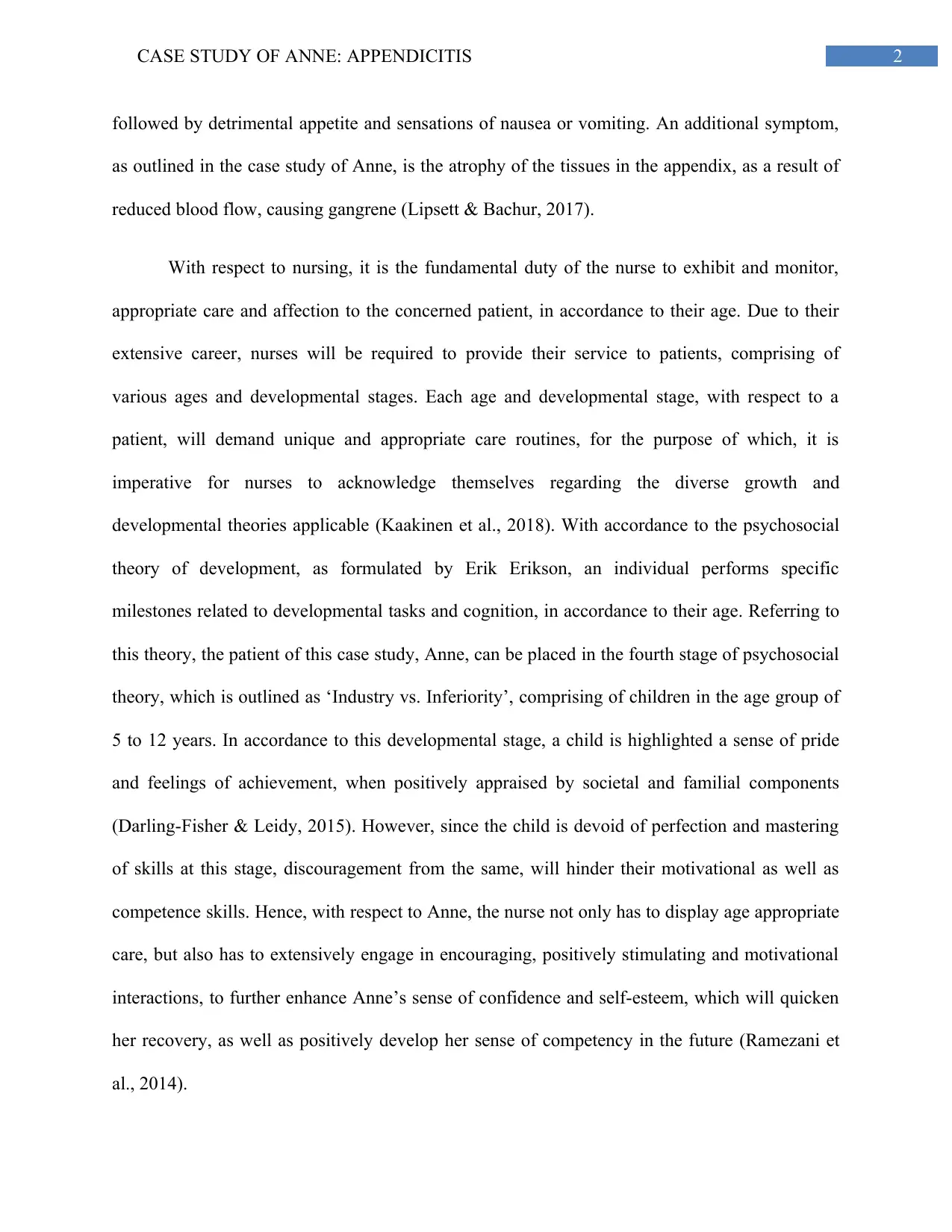
2CASE STUDY OF ANNE: APPENDICITIS
followed by detrimental appetite and sensations of nausea or vomiting. An additional symptom,
as outlined in the case study of Anne, is the atrophy of the tissues in the appendix, as a result of
reduced blood flow, causing gangrene (Lipsett & Bachur, 2017).
With respect to nursing, it is the fundamental duty of the nurse to exhibit and monitor,
appropriate care and affection to the concerned patient, in accordance to their age. Due to their
extensive career, nurses will be required to provide their service to patients, comprising of
various ages and developmental stages. Each age and developmental stage, with respect to a
patient, will demand unique and appropriate care routines, for the purpose of which, it is
imperative for nurses to acknowledge themselves regarding the diverse growth and
developmental theories applicable (Kaakinen et al., 2018). With accordance to the psychosocial
theory of development, as formulated by Erik Erikson, an individual performs specific
milestones related to developmental tasks and cognition, in accordance to their age. Referring to
this theory, the patient of this case study, Anne, can be placed in the fourth stage of psychosocial
theory, which is outlined as ‘Industry vs. Inferiority’, comprising of children in the age group of
5 to 12 years. In accordance to this developmental stage, a child is highlighted a sense of pride
and feelings of achievement, when positively appraised by societal and familial components
(Darling-Fisher & Leidy, 2015). However, since the child is devoid of perfection and mastering
of skills at this stage, discouragement from the same, will hinder their motivational as well as
competence skills. Hence, with respect to Anne, the nurse not only has to display age appropriate
care, but also has to extensively engage in encouraging, positively stimulating and motivational
interactions, to further enhance Anne’s sense of confidence and self-esteem, which will quicken
her recovery, as well as positively develop her sense of competency in the future (Ramezani et
al., 2014).
followed by detrimental appetite and sensations of nausea or vomiting. An additional symptom,
as outlined in the case study of Anne, is the atrophy of the tissues in the appendix, as a result of
reduced blood flow, causing gangrene (Lipsett & Bachur, 2017).
With respect to nursing, it is the fundamental duty of the nurse to exhibit and monitor,
appropriate care and affection to the concerned patient, in accordance to their age. Due to their
extensive career, nurses will be required to provide their service to patients, comprising of
various ages and developmental stages. Each age and developmental stage, with respect to a
patient, will demand unique and appropriate care routines, for the purpose of which, it is
imperative for nurses to acknowledge themselves regarding the diverse growth and
developmental theories applicable (Kaakinen et al., 2018). With accordance to the psychosocial
theory of development, as formulated by Erik Erikson, an individual performs specific
milestones related to developmental tasks and cognition, in accordance to their age. Referring to
this theory, the patient of this case study, Anne, can be placed in the fourth stage of psychosocial
theory, which is outlined as ‘Industry vs. Inferiority’, comprising of children in the age group of
5 to 12 years. In accordance to this developmental stage, a child is highlighted a sense of pride
and feelings of achievement, when positively appraised by societal and familial components
(Darling-Fisher & Leidy, 2015). However, since the child is devoid of perfection and mastering
of skills at this stage, discouragement from the same, will hinder their motivational as well as
competence skills. Hence, with respect to Anne, the nurse not only has to display age appropriate
care, but also has to extensively engage in encouraging, positively stimulating and motivational
interactions, to further enhance Anne’s sense of confidence and self-esteem, which will quicken
her recovery, as well as positively develop her sense of competency in the future (Ramezani et
al., 2014).
⊘ This is a preview!⊘
Do you want full access?
Subscribe today to unlock all pages.

Trusted by 1+ million students worldwide
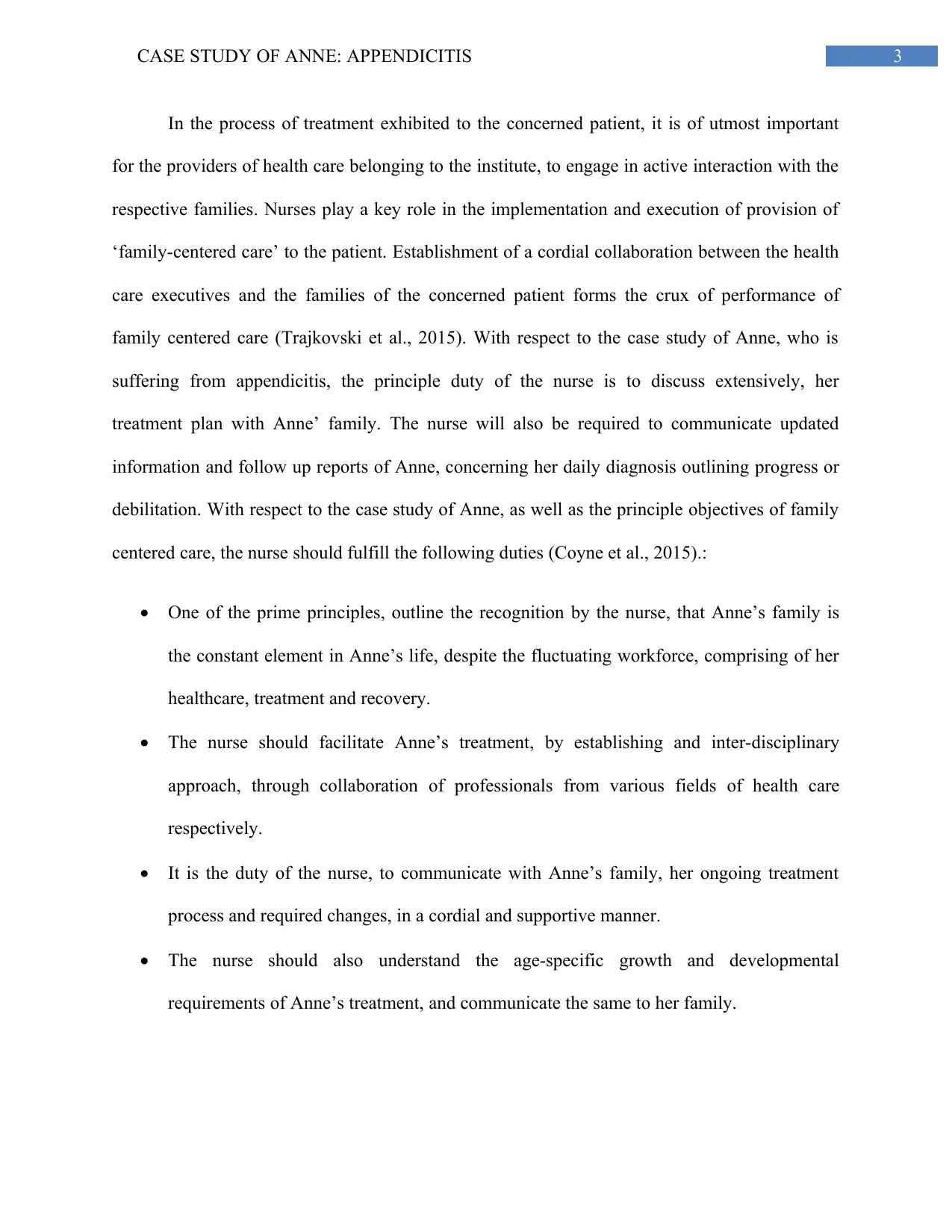
3CASE STUDY OF ANNE: APPENDICITIS
In the process of treatment exhibited to the concerned patient, it is of utmost important
for the providers of health care belonging to the institute, to engage in active interaction with the
respective families. Nurses play a key role in the implementation and execution of provision of
‘family-centered care’ to the patient. Establishment of a cordial collaboration between the health
care executives and the families of the concerned patient forms the crux of performance of
family centered care (Trajkovski et al., 2015). With respect to the case study of Anne, who is
suffering from appendicitis, the principle duty of the nurse is to discuss extensively, her
treatment plan with Anne’ family. The nurse will also be required to communicate updated
information and follow up reports of Anne, concerning her daily diagnosis outlining progress or
debilitation. With respect to the case study of Anne, as well as the principle objectives of family
centered care, the nurse should fulfill the following duties (Coyne et al., 2015).:
One of the prime principles, outline the recognition by the nurse, that Anne’s family is
the constant element in Anne’s life, despite the fluctuating workforce, comprising of her
healthcare, treatment and recovery.
The nurse should facilitate Anne’s treatment, by establishing and inter-disciplinary
approach, through collaboration of professionals from various fields of health care
respectively.
It is the duty of the nurse, to communicate with Anne’s family, her ongoing treatment
process and required changes, in a cordial and supportive manner.
The nurse should also understand the age-specific growth and developmental
requirements of Anne’s treatment, and communicate the same to her family.
In the process of treatment exhibited to the concerned patient, it is of utmost important
for the providers of health care belonging to the institute, to engage in active interaction with the
respective families. Nurses play a key role in the implementation and execution of provision of
‘family-centered care’ to the patient. Establishment of a cordial collaboration between the health
care executives and the families of the concerned patient forms the crux of performance of
family centered care (Trajkovski et al., 2015). With respect to the case study of Anne, who is
suffering from appendicitis, the principle duty of the nurse is to discuss extensively, her
treatment plan with Anne’ family. The nurse will also be required to communicate updated
information and follow up reports of Anne, concerning her daily diagnosis outlining progress or
debilitation. With respect to the case study of Anne, as well as the principle objectives of family
centered care, the nurse should fulfill the following duties (Coyne et al., 2015).:
One of the prime principles, outline the recognition by the nurse, that Anne’s family is
the constant element in Anne’s life, despite the fluctuating workforce, comprising of her
healthcare, treatment and recovery.
The nurse should facilitate Anne’s treatment, by establishing and inter-disciplinary
approach, through collaboration of professionals from various fields of health care
respectively.
It is the duty of the nurse, to communicate with Anne’s family, her ongoing treatment
process and required changes, in a cordial and supportive manner.
The nurse should also understand the age-specific growth and developmental
requirements of Anne’s treatment, and communicate the same to her family.
Paraphrase This Document
Need a fresh take? Get an instant paraphrase of this document with our AI Paraphraser
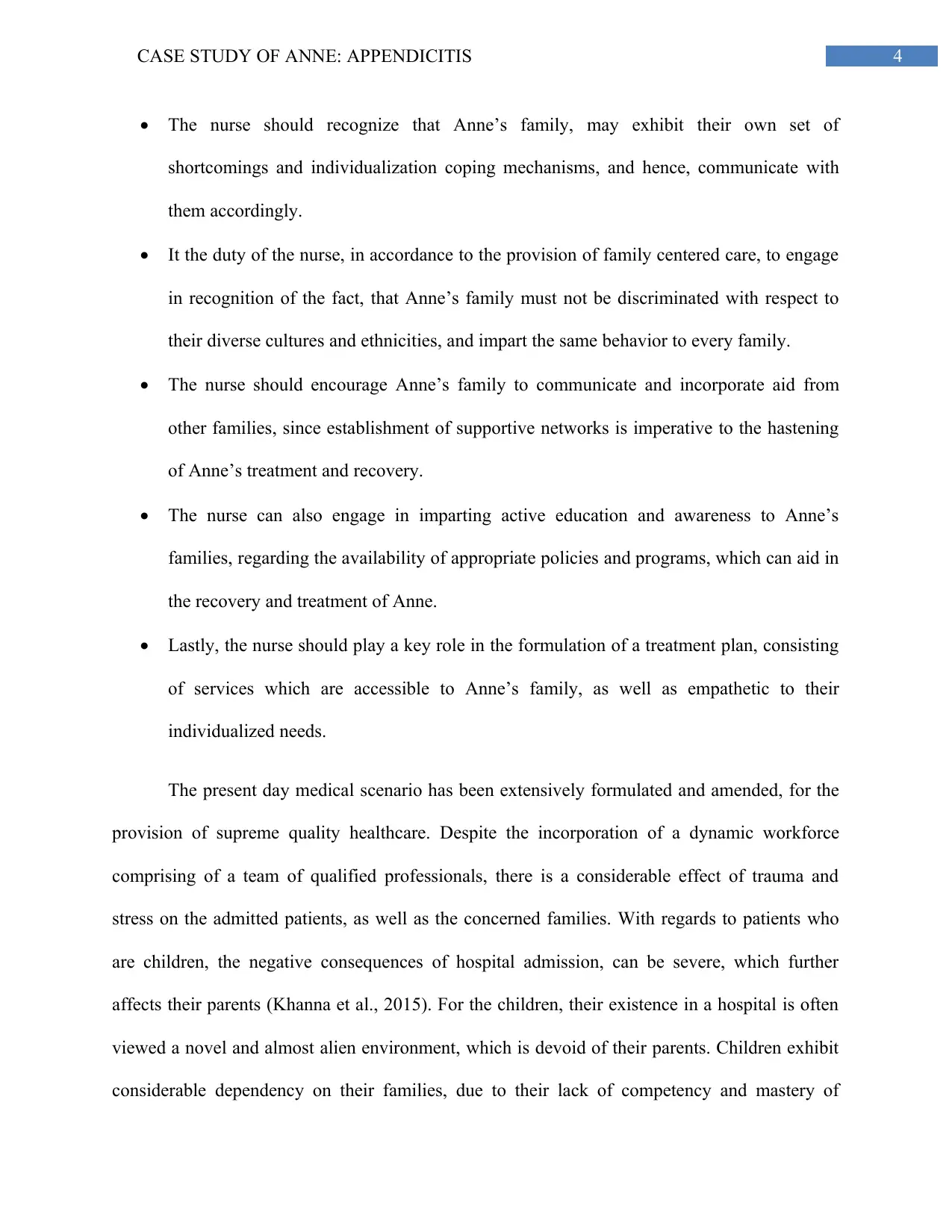
4CASE STUDY OF ANNE: APPENDICITIS
The nurse should recognize that Anne’s family, may exhibit their own set of
shortcomings and individualization coping mechanisms, and hence, communicate with
them accordingly.
It the duty of the nurse, in accordance to the provision of family centered care, to engage
in recognition of the fact, that Anne’s family must not be discriminated with respect to
their diverse cultures and ethnicities, and impart the same behavior to every family.
The nurse should encourage Anne’s family to communicate and incorporate aid from
other families, since establishment of supportive networks is imperative to the hastening
of Anne’s treatment and recovery.
The nurse can also engage in imparting active education and awareness to Anne’s
families, regarding the availability of appropriate policies and programs, which can aid in
the recovery and treatment of Anne.
Lastly, the nurse should play a key role in the formulation of a treatment plan, consisting
of services which are accessible to Anne’s family, as well as empathetic to their
individualized needs.
The present day medical scenario has been extensively formulated and amended, for the
provision of supreme quality healthcare. Despite the incorporation of a dynamic workforce
comprising of a team of qualified professionals, there is a considerable effect of trauma and
stress on the admitted patients, as well as the concerned families. With regards to patients who
are children, the negative consequences of hospital admission, can be severe, which further
affects their parents (Khanna et al., 2015). For the children, their existence in a hospital is often
viewed a novel and almost alien environment, which is devoid of their parents. Children exhibit
considerable dependency on their families, due to their lack of competency and mastery of
The nurse should recognize that Anne’s family, may exhibit their own set of
shortcomings and individualization coping mechanisms, and hence, communicate with
them accordingly.
It the duty of the nurse, in accordance to the provision of family centered care, to engage
in recognition of the fact, that Anne’s family must not be discriminated with respect to
their diverse cultures and ethnicities, and impart the same behavior to every family.
The nurse should encourage Anne’s family to communicate and incorporate aid from
other families, since establishment of supportive networks is imperative to the hastening
of Anne’s treatment and recovery.
The nurse can also engage in imparting active education and awareness to Anne’s
families, regarding the availability of appropriate policies and programs, which can aid in
the recovery and treatment of Anne.
Lastly, the nurse should play a key role in the formulation of a treatment plan, consisting
of services which are accessible to Anne’s family, as well as empathetic to their
individualized needs.
The present day medical scenario has been extensively formulated and amended, for the
provision of supreme quality healthcare. Despite the incorporation of a dynamic workforce
comprising of a team of qualified professionals, there is a considerable effect of trauma and
stress on the admitted patients, as well as the concerned families. With regards to patients who
are children, the negative consequences of hospital admission, can be severe, which further
affects their parents (Khanna et al., 2015). For the children, their existence in a hospital is often
viewed a novel and almost alien environment, which is devoid of their parents. Children exhibit
considerable dependency on their families, due to their lack of competency and mastery of
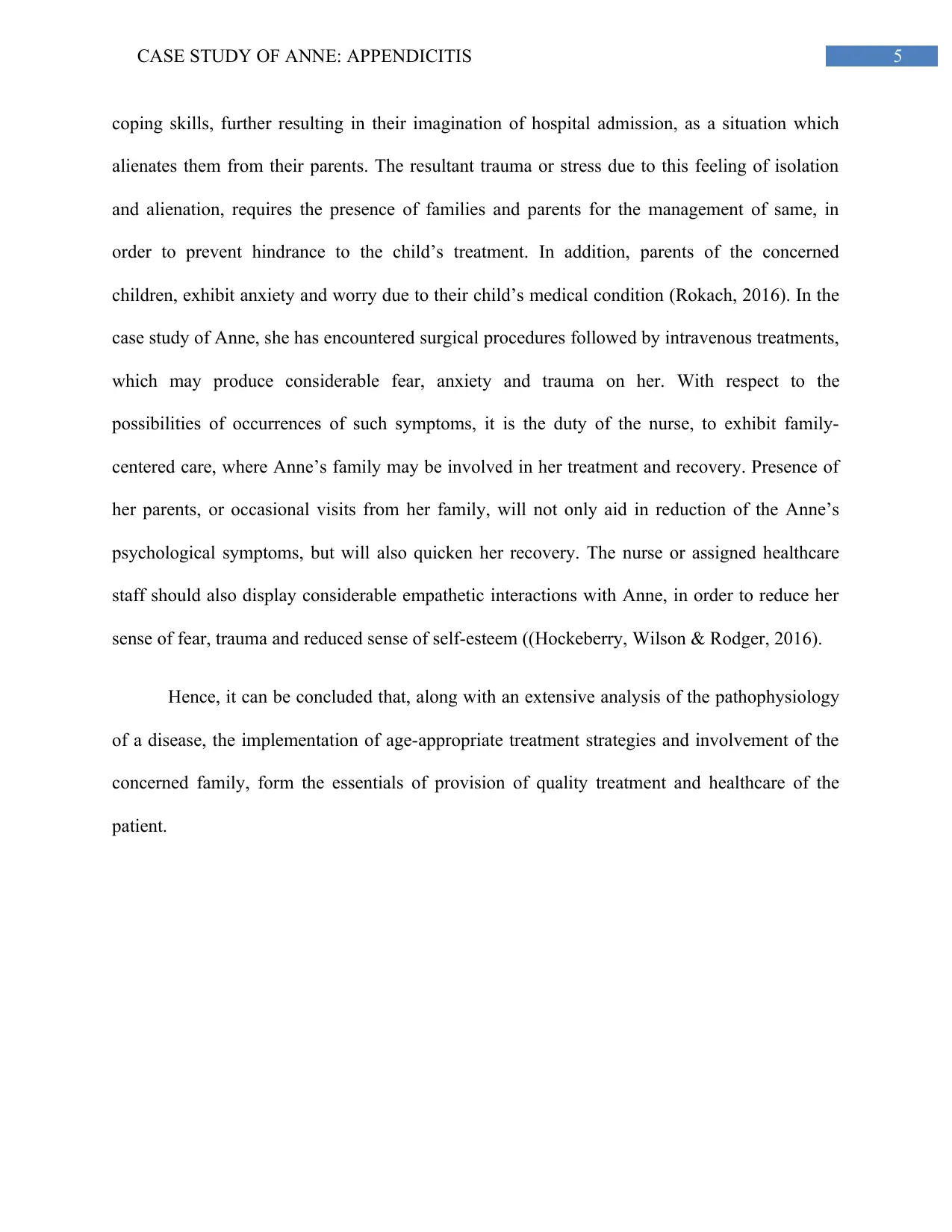
5CASE STUDY OF ANNE: APPENDICITIS
coping skills, further resulting in their imagination of hospital admission, as a situation which
alienates them from their parents. The resultant trauma or stress due to this feeling of isolation
and alienation, requires the presence of families and parents for the management of same, in
order to prevent hindrance to the child’s treatment. In addition, parents of the concerned
children, exhibit anxiety and worry due to their child’s medical condition (Rokach, 2016). In the
case study of Anne, she has encountered surgical procedures followed by intravenous treatments,
which may produce considerable fear, anxiety and trauma on her. With respect to the
possibilities of occurrences of such symptoms, it is the duty of the nurse, to exhibit family-
centered care, where Anne’s family may be involved in her treatment and recovery. Presence of
her parents, or occasional visits from her family, will not only aid in reduction of the Anne’s
psychological symptoms, but will also quicken her recovery. The nurse or assigned healthcare
staff should also display considerable empathetic interactions with Anne, in order to reduce her
sense of fear, trauma and reduced sense of self-esteem ((Hockeberry, Wilson & Rodger, 2016).
Hence, it can be concluded that, along with an extensive analysis of the pathophysiology
of a disease, the implementation of age-appropriate treatment strategies and involvement of the
concerned family, form the essentials of provision of quality treatment and healthcare of the
patient.
coping skills, further resulting in their imagination of hospital admission, as a situation which
alienates them from their parents. The resultant trauma or stress due to this feeling of isolation
and alienation, requires the presence of families and parents for the management of same, in
order to prevent hindrance to the child’s treatment. In addition, parents of the concerned
children, exhibit anxiety and worry due to their child’s medical condition (Rokach, 2016). In the
case study of Anne, she has encountered surgical procedures followed by intravenous treatments,
which may produce considerable fear, anxiety and trauma on her. With respect to the
possibilities of occurrences of such symptoms, it is the duty of the nurse, to exhibit family-
centered care, where Anne’s family may be involved in her treatment and recovery. Presence of
her parents, or occasional visits from her family, will not only aid in reduction of the Anne’s
psychological symptoms, but will also quicken her recovery. The nurse or assigned healthcare
staff should also display considerable empathetic interactions with Anne, in order to reduce her
sense of fear, trauma and reduced sense of self-esteem ((Hockeberry, Wilson & Rodger, 2016).
Hence, it can be concluded that, along with an extensive analysis of the pathophysiology
of a disease, the implementation of age-appropriate treatment strategies and involvement of the
concerned family, form the essentials of provision of quality treatment and healthcare of the
patient.
⊘ This is a preview!⊘
Do you want full access?
Subscribe today to unlock all pages.

Trusted by 1+ million students worldwide
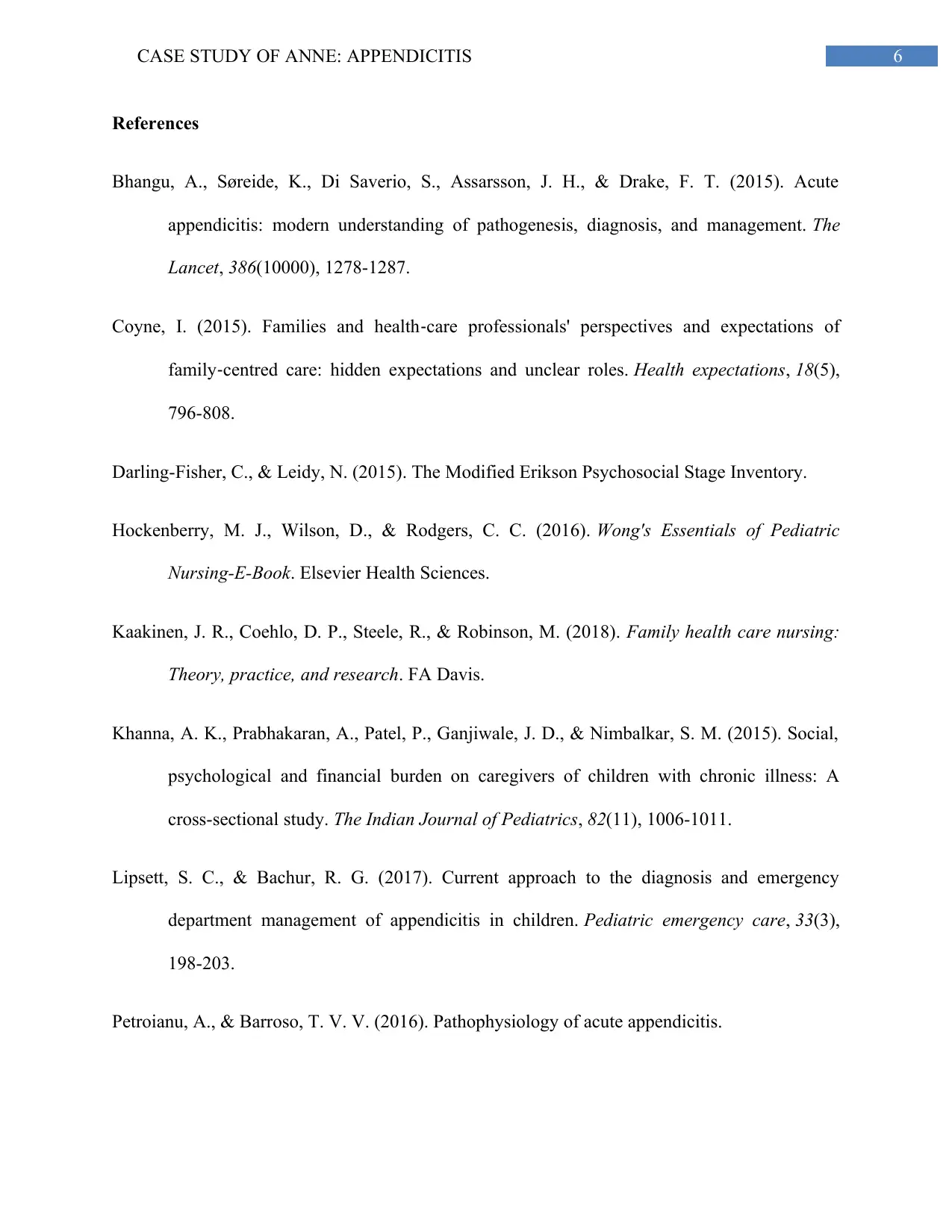
6CASE STUDY OF ANNE: APPENDICITIS
References
Bhangu, A., Søreide, K., Di Saverio, S., Assarsson, J. H., & Drake, F. T. (2015). Acute
appendicitis: modern understanding of pathogenesis, diagnosis, and management. The
Lancet, 386(10000), 1278-1287.
Coyne, I. (2015). Families and health‐care professionals' perspectives and expectations of
family‐centred care: hidden expectations and unclear roles. Health expectations, 18(5),
796-808.
Darling-Fisher, C., & Leidy, N. (2015). The Modified Erikson Psychosocial Stage Inventory.
Hockenberry, M. J., Wilson, D., & Rodgers, C. C. (2016). Wong's Essentials of Pediatric
Nursing-E-Book. Elsevier Health Sciences.
Kaakinen, J. R., Coehlo, D. P., Steele, R., & Robinson, M. (2018). Family health care nursing:
Theory, practice, and research. FA Davis.
Khanna, A. K., Prabhakaran, A., Patel, P., Ganjiwale, J. D., & Nimbalkar, S. M. (2015). Social,
psychological and financial burden on caregivers of children with chronic illness: A
cross-sectional study. The Indian Journal of Pediatrics, 82(11), 1006-1011.
Lipsett, S. C., & Bachur, R. G. (2017). Current approach to the diagnosis and emergency
department management of appendicitis in children. Pediatric emergency care, 33(3),
198-203.
Petroianu, A., & Barroso, T. V. V. (2016). Pathophysiology of acute appendicitis.
References
Bhangu, A., Søreide, K., Di Saverio, S., Assarsson, J. H., & Drake, F. T. (2015). Acute
appendicitis: modern understanding of pathogenesis, diagnosis, and management. The
Lancet, 386(10000), 1278-1287.
Coyne, I. (2015). Families and health‐care professionals' perspectives and expectations of
family‐centred care: hidden expectations and unclear roles. Health expectations, 18(5),
796-808.
Darling-Fisher, C., & Leidy, N. (2015). The Modified Erikson Psychosocial Stage Inventory.
Hockenberry, M. J., Wilson, D., & Rodgers, C. C. (2016). Wong's Essentials of Pediatric
Nursing-E-Book. Elsevier Health Sciences.
Kaakinen, J. R., Coehlo, D. P., Steele, R., & Robinson, M. (2018). Family health care nursing:
Theory, practice, and research. FA Davis.
Khanna, A. K., Prabhakaran, A., Patel, P., Ganjiwale, J. D., & Nimbalkar, S. M. (2015). Social,
psychological and financial burden on caregivers of children with chronic illness: A
cross-sectional study. The Indian Journal of Pediatrics, 82(11), 1006-1011.
Lipsett, S. C., & Bachur, R. G. (2017). Current approach to the diagnosis and emergency
department management of appendicitis in children. Pediatric emergency care, 33(3),
198-203.
Petroianu, A., & Barroso, T. V. V. (2016). Pathophysiology of acute appendicitis.
Paraphrase This Document
Need a fresh take? Get an instant paraphrase of this document with our AI Paraphraser
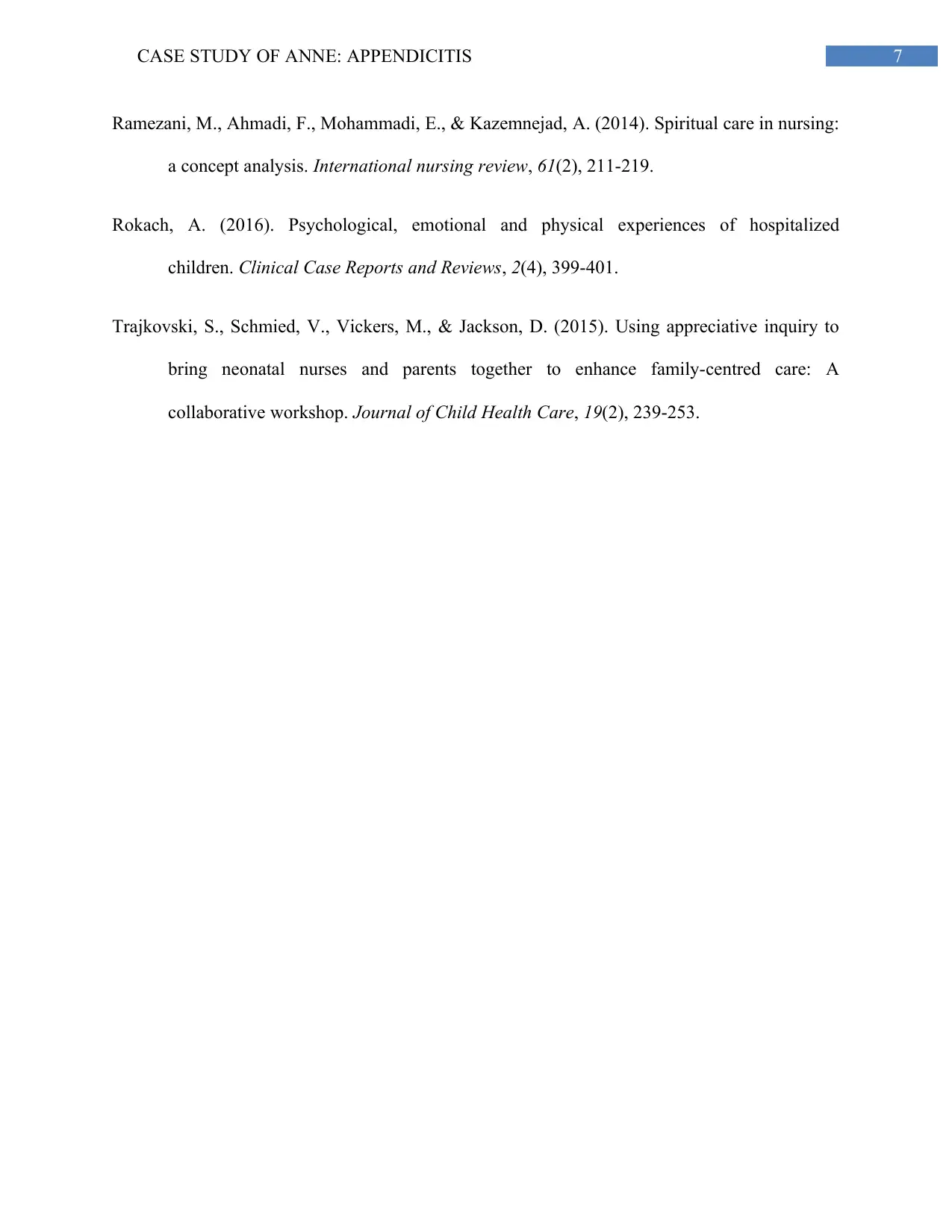
7CASE STUDY OF ANNE: APPENDICITIS
Ramezani, M., Ahmadi, F., Mohammadi, E., & Kazemnejad, A. (2014). Spiritual care in nursing:
a concept analysis. International nursing review, 61(2), 211-219.
Rokach, A. (2016). Psychological, emotional and physical experiences of hospitalized
children. Clinical Case Reports and Reviews, 2(4), 399-401.
Trajkovski, S., Schmied, V., Vickers, M., & Jackson, D. (2015). Using appreciative inquiry to
bring neonatal nurses and parents together to enhance family-centred care: A
collaborative workshop. Journal of Child Health Care, 19(2), 239-253.
Ramezani, M., Ahmadi, F., Mohammadi, E., & Kazemnejad, A. (2014). Spiritual care in nursing:
a concept analysis. International nursing review, 61(2), 211-219.
Rokach, A. (2016). Psychological, emotional and physical experiences of hospitalized
children. Clinical Case Reports and Reviews, 2(4), 399-401.
Trajkovski, S., Schmied, V., Vickers, M., & Jackson, D. (2015). Using appreciative inquiry to
bring neonatal nurses and parents together to enhance family-centred care: A
collaborative workshop. Journal of Child Health Care, 19(2), 239-253.
1 out of 8
Related Documents
Your All-in-One AI-Powered Toolkit for Academic Success.
+13062052269
info@desklib.com
Available 24*7 on WhatsApp / Email
![[object Object]](/_next/static/media/star-bottom.7253800d.svg)
Unlock your academic potential
Copyright © 2020–2025 A2Z Services. All Rights Reserved. Developed and managed by ZUCOL.





